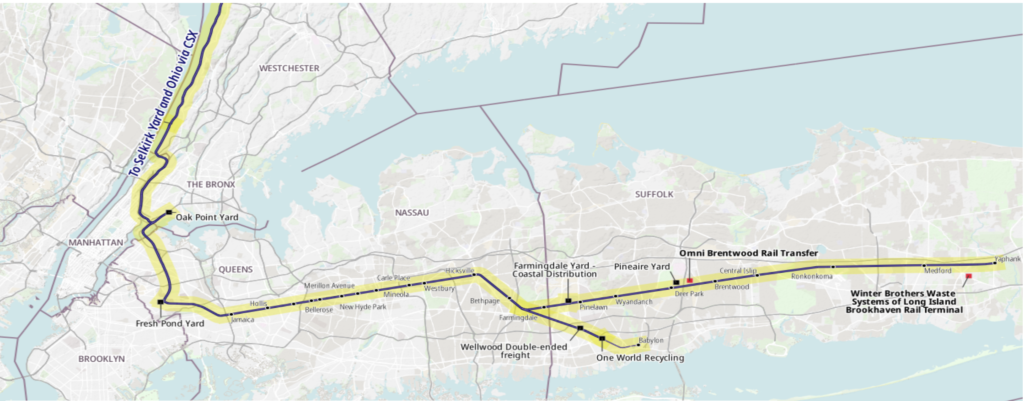When Fresh Kills landfill closed without a plan to deal with the massive flow of daily trucked trash, new community burdens from waste export to landfills began. Queens Community Board 5 is one of many community boards impacted by waste-by-rail export. Others are Queens CB 2, 9, 12, and 13. New York City also allowed transfer stations processing waste for export to locate near residential areas, including in Queens Community Board 12.
Residents in CB 12 who live near these waste transfer stations experience foul odors, diesel exhaust, waste blowoff and leachate, noise, and disruption from outmoded transfer stations and waste transport. In summer, they’re unable to use their backyards or open their windows. Sound familiar? Residents of CB-5 have experienced a version of these problems and others. Neighborhoods of CB-5 are used for rail car storage and freight rail operations that produce excessive noise and vibration, and block grade crossings. And things are about to get worse.
On February 27, 2020, Newsday reported a Long Island Planning Council meeting about what to do with Nassau and Suffolk Counties’ trash when the Town of Brookhaven’s landfill closes in 2024, “’No, it’s not a looming crisis. It’s now,’ (Brookhaven Supervisor Edward P.) Romaine told the standing-room-only crowd of about 100 people gathered in Melville. ‘Either we get together as a region to resolve this and have a path forward, or this is going to be yet another thing that makes Long Island less desirable to live, work, play, etcetera. Either we start addressing this, or we’re going to suffer.’”
Will Flowers of Winter Brothers Waste Systems, who was at that meeting, has the answer to their solid waste disposal crisis: more waste-by-rail exported through Queens.
This map shows how exported waste-by-rail travels from Suffolk County transfer stations via Long Island and Queens, and that every ounce must come to 10-acre Fresh Pond Yard. The map also shows existing and planned waste-by-rail transfer stations in Suffolk County, and rail facilities that serve them. The yellow zone indicates residents within 1 km of waste-by-rail facilities, who experience the worst pollution impacts from 1970’s diesel locomotive emissions and/or waste blowoff and leachate — including more than 750,000 Queens residents. (Map and table courtesy of BetaNYC and the Queens Solid Waste Advisory Board Organizing Committee)
Waste cars comprised a third of NYA’s 30,000 annual carloads in 2018. Former NYA President Paul Victor stated that Fresh Pond Yard’s capacity limit is 40,000 annual carloads, i.e., 40,000 full rail cars and about the same number of empties, so about 80,000 full and empty rail cars a year. However, the Department of Environmental Conservation in Region 1 has been permitting Suffolk County waste-by-rail transfer stations on a site-by-site basis, without regard to the capacity of Fresh Pond Yard and associated community impacts. You can see two planned waste-by-rail transfer stations on the map: Omni Brentwood Rail Transfer and Winter Brothers Waste Systems, which has acquired its own railroad and a 228-acre property for this new business venture. Their current combined plans are for processing up to 4,300 tons of trash a day, which is more than 10,000 additional carloads a year! This is what’s planned for Fresh Pond Yard.
In September 2020, NYA President Bonner told CB-5 he must store rail cars covered with graffiti up on the bridge at Myrtle Ave. and Fresh Pond Rd. because he has nowhere else to put them. The unsightly cars are a poke in the eye to a proud community that has spent tens of thousands of dollars a year and countless hours combating graffiti. NYA crews have been working at the grade crossing at 73rd St. and Edsall Ave. for up to thirty minutes at a time. They block the crossing, making it impossible for people who live and work there to leave and for emergency services to reach them, if needed. This points to capacity limitations. So where is the plan to deal with the planned massive inflow of daily waste-by-rail? NYA says they’re already jammed up.
In October 2020, CB-5 and elected officials sent public comments asking the NYS Department of Environmental Conservation Region 1 to deny the Omni Brentwood Rail Transfer permit application until waste-by-rail problems are addressed more comprehensively. In the same way that the Long Island Planning Council is figuring out how to deal with greater Long Island’s trash so they maintain desirable quality of life in their communities, the power lies with Queens elected officials to initiate regional planning that does the same for their constituents.
Our families need regional solid waste management and transportation planning that includes relief for current problems and protection for our neighborhoods in the future. Enhanced regulation and enforcement, and technological and facilities upgrades are long overdue. However, unless our elected officials act quickly, anticipated and unanticipated adverse impacts and community burdens from waste export to landfills will persist and increase in Queens — as adverse impacts of Fresh Kills’ closure linger, and waste-by-rail from Nassau and Suffolk exponentially increases.




